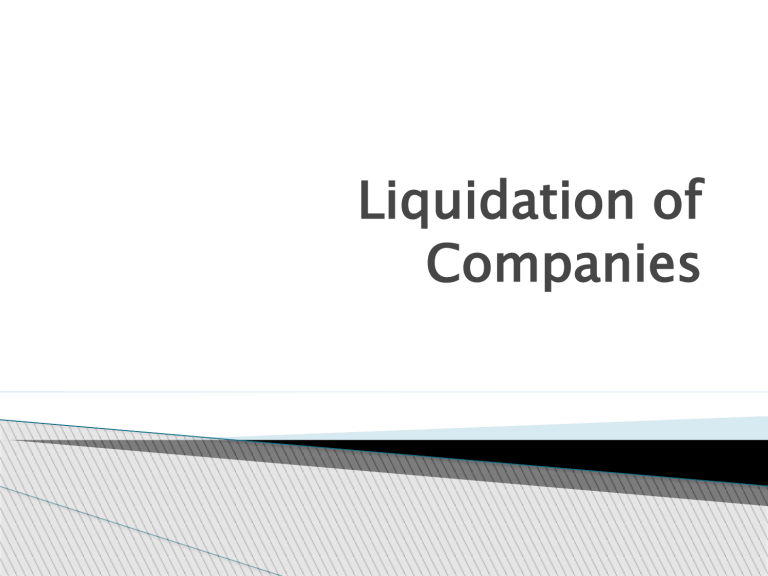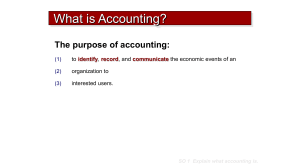
Liquidation of Companies Introduction A company is a creation of law and it can come to an end only through a process of law. A company ceases to exist when it is dissolved. One of the ways to dissolve a company is to resort to the process of winding up or liquidation. When winding up commences the company is said to be in liquidation. It is not necessary that only an insolvent company should be liquidated. Sometimes it is necessary to liquidate or wind up even a prosperous and solvent company. The Company Act 2013 lays down the procedure by which the company can be wound up. Modes of winding up Compulsory winding up Voluntary winding up Winding up under the supervision of the court Compulsory winding up the company has a special resolution resolved that the company may be wound up by the court Statutory report not delivered to the Registrar Not commence business within one year from its incorporation or suspends t for whole year If the number of members are reduced Unable to pay debts Voluntary winding up Member voluntary winding up Creditors voluntary winding up Member voluntary winding up This type of winding up occurs only when the company is solvent A declaration of the company solvency at the BOD meeting, stating that the company has no debts or it will be able to pay its debts in full within three years of the commencement of the winding up At the general meeting a liquidator is appointed and his remuneration is fixed. Creditors voluntary winding up It occurs in the absence of declaration of solvency that is when the company is insolvent. Both at member meeting and creditors meeting liquidator is nominated, in case of disagreement the creditors nominee is appointed The liquidator must annually call not only the members but also creditors meeting. Winding up subject to supervision of court The court may intervene only incase of following circumstances: ◦ If the resolution for winding up was obtained by fraud by the company ◦ If the rules pertaining to winding up are not properly followed ◦ If the liquidator is found to be negligent in releasing the assets of the company Consequences of liquidation Liquidator will take over the administration of the company The powers of the BODs will terminate and will now vest in the liquidator No suit or legal proceedings can be proceed with against the company except with the permission of the court. The order for winding up has the effect of a notice of discharge to the employees of the company except where the business of the company is continued by the order of the court. A shareholder is liable to pay the full amount up to the face value of the shares held by him. Incase of solvent company all claims of its creditors when proved are fully met and incase of insolvent company the rules under the law of insolvency hall apply. Order of payment The following amounts are realized by the liquidator; ◦ ◦ ◦ ◦ From the debtors of the company From sale proceeds of the assets of the company The surplus amount from fully secured creditors By making calls for the amount remaining unpaid on the shares. Payments are done in the following order Secured creditors Legal expenses Remuneration of the liquidator Expenses and cost of winding up Payment to preferential creditors Payment to debenture holders and creditors who have floating charge on the assets of the company ◦ Payment to unsecured or ordinary creditors ◦ Payment to members or contributories (if balance remains) ◦ ◦ ◦ ◦ ◦ ◦ Remuneration of liquidator form of commission based on the assets realized, cash and bank balance is not included unless specified Surplus of secured creditors is mostly included in the amount realized If remuneration is paid on amount distributed to unsecured creditors, If (un)sufficient amount is available to pay all creditors then the remuneration ◦ Amount of Unsecured creditors * percentage ◦ Amount of Unsecured creditors * percentage/100+ percentage of commission The liquidator’s job is to realize the assets of the company and pay the creditors (including Revenue) from the proceeds. Where there are insufficient assets to pay all the creditors, the funds available are distributed in a preset order The end result is that the company is removed from the Companies Register and ceases to have legal existence. Statement of Affairs List A- list of assets which are not in hand or Pledged in favor of secured creditors List B-List of assets which are specifically pledged with creditors both fully and partly secured List C list of Preferential Creditors and mount due List D- List of Debenture holders having floating charges List E – List of Unsecured creditors and amount due List F- List of names and holding of Preferential shareholders List G- List of Equity shareholders and the amount of Shares held List H- Statement showing the surplus or Defficiency in the statement of Affairs arose due to profit or loss of the compant Accounting Procedure Appointment of Liquidators Statement of profit and Loss account and Balance sheet Statement of Affairs / Surplus and Deficiency Liquidators Final statement of Account
![FORM NO. 157 [See rule 331] COMPANIES ACT. 1956 Members](http://s3.studylib.net/store/data/008659599_1-2c9a22f370f2c285423bce1fc3cf3305-300x300.png)

